2023 HYUNDAI IONIQ 6 instrument cluster
[x] Cancel search: instrument clusterPage 451 of 582
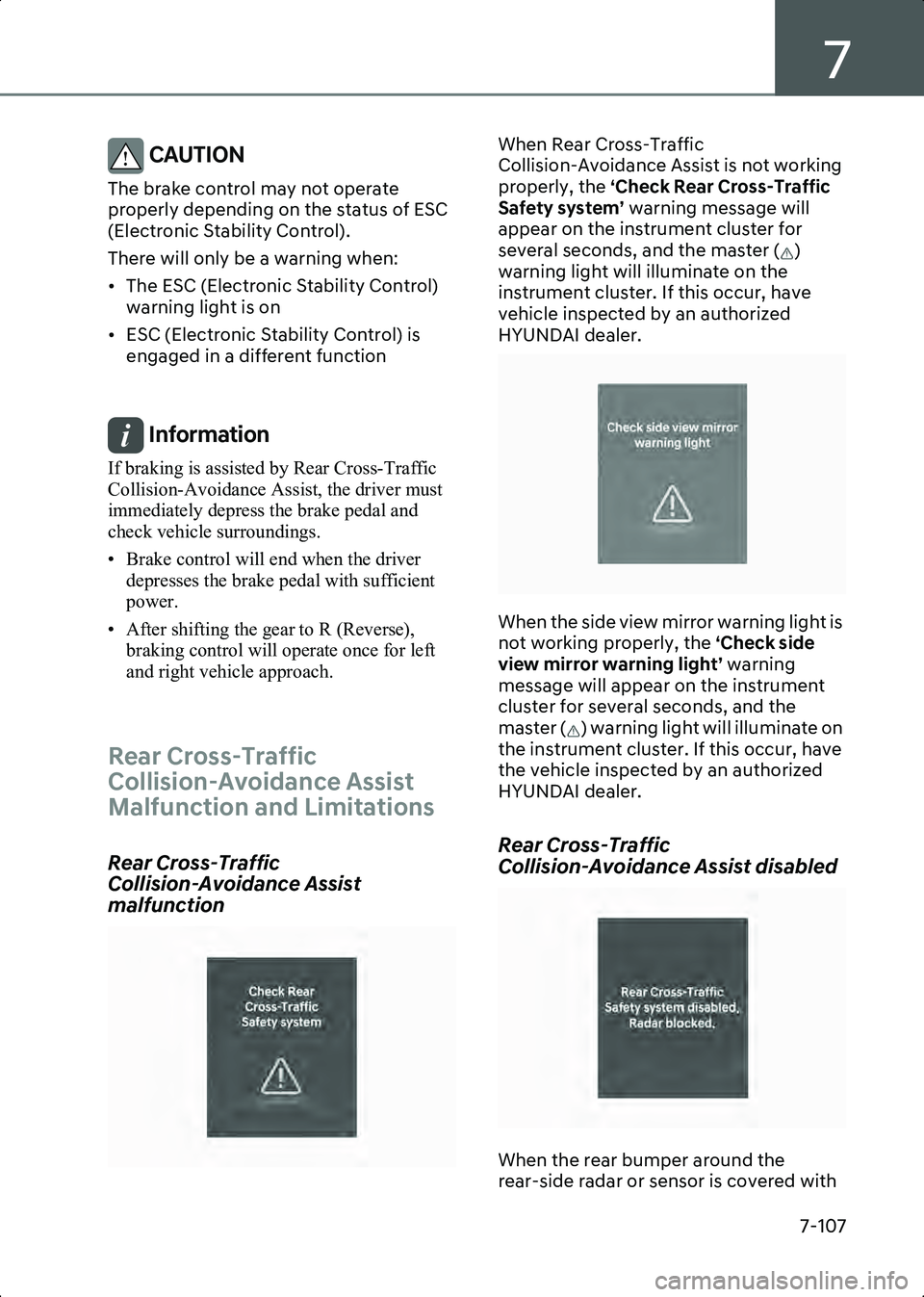
7
7-107
CAUTION The brake control may not operate
properly depending on the status of ESC
(Electronic Stability Control).
There will only be a warning when:
• The ESC (Electronic Stability Control) warning light is on
• ESC (Electronic Stability Control) is engaged in a different function
Information If braking is assisted by Rear Cross-Traffic
Collision-Avoidance Assist, the driver must
immediately depress the brake pedal and
check vehicle surroundings.
• Brake control will end when the driver depresses the brake pedal with sufficient
power.
• After shifting the gear to R (Reverse), braking control will operate once for left
and right vehicle approach.
Rear Cross-Traffic
Collision-Avoidance Assist
Malfunction and Limitations
Rear Cross-Traffic
Collision-Avoidance Assist
malfunction
B7006901
When Rear Cross-Traffic
Collision-Avoidance Assist is not working
properly, the ‘Check Rear Cross-Traffic
Safety system’ warning message will
appear on the instrument cluster for
several seconds, and the master ( )
warning light will illuminate on the
instrument cluster. If this occur, have
vehicle inspected by an authorized
HYUNDAI dealer.
B7001602
When the side view mirror warning light is
not working properly, the ‘Check side
view mirror warning light’ warning
message will appear on the instrument
cluster for several seconds, and the
master ( ) warning light will illuminate on
the instrument cluster. If this occur, have
the vehicle inspected by an authorized
HYUNDAI dealer.
Rear Cross-Traffic
Collision-Avoidance Assist disabled
B7006903
When the rear bumper around the
rear-side radar or sensor is covered with
Hyundai_CE_en_US.book Page 107
Page 452 of 582
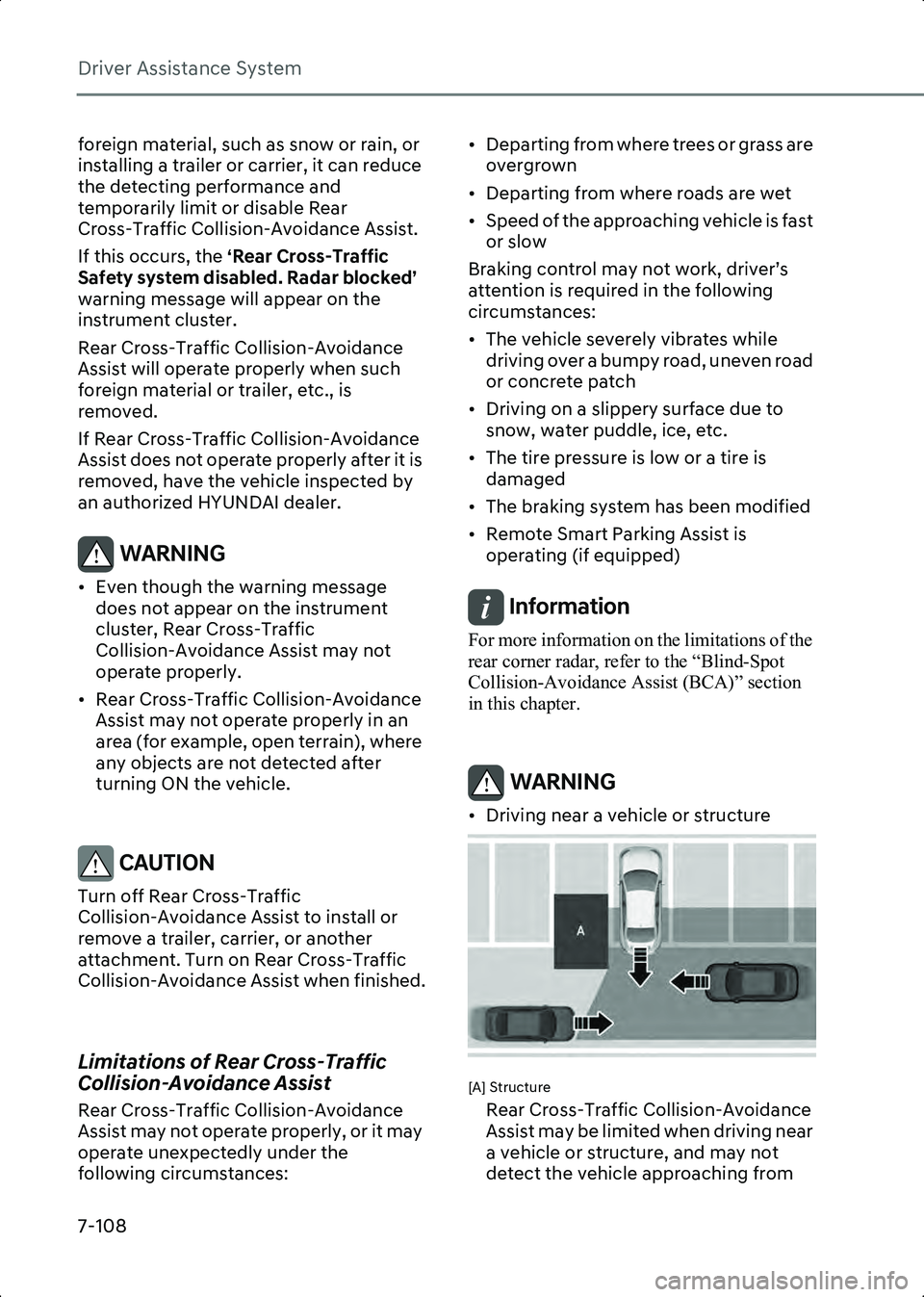
Driver Assistance System
7-108
foreign material, such as snow or rain, or
installing a trailer or carrier, it can reduce
the detecting performance and
temporarily limit or disable Rear
Cross-Traffic Collision-Avoidance Assist.
If this occurs, the ‘Rear Cross-Traffic
Safety system disabled. Radar blocked’
warning message will appear on the
instrument cluster.
Rear Cross-Traffic Collision-Avoidance
Assist will operate properly when such
foreign material or trailer, etc., is
removed.
If Rear Cross-Traffic Collision-Avoidance
Assist does not operate properly after it is
removed, have the vehicle inspected by
an authorized HYUNDAI dealer.
WARNING • Even though the warning message does not appear on the instrument
cluster, Rear Cross-Traffic
Collision-Avoidance Assist may not
operate properly.
• Rear Cross-Traffic Collision-Avoidance Assist may not operate properly in an
area (for example, open terrain), where
any objects are not detected after
turning ON the vehicle.
CAUTION Turn off Rear Cross-Traffic
Collision-Avoidance Assist to install or
remove a trailer, carrier, or another
attachment. Turn on Rear Cross-Traffic
Collision-Avoidance Assist when finished.
Limitations of Rear Cross-Traffic
Collision-Avoidance Assist
Rear Cross-Traffic Collision-Avoidance
Assist may not operate properly, or it may
operate unexpectedly under the
following circumstances: • Departing from where trees or grass are
overgrown
• Departing from where roads are wet
• Speed of the approaching vehicle is fast or slow
Braking control may not work, driver’s
attention is required in the following
circumstances:
• The vehicle severely vibrates while driving over a bumpy road, uneven road
or concrete patch
• Driving on a slippery surface due to snow, water puddle, ice, etc.
• The tire pressure is low or a tire is damaged
• The braking system has been modified
• Remote Smart Parking Assist is operating (if equipped)
Information For more information on the limitations of the
rear corner radar, refer to the “Blind-Spot
Collision-Avoidance Assist (BCA)” section
in this chapter.
WARNING • Driving near a vehicle or structure
B7006904
[A] Structure
Rear Cross-Traffic Collision-Avoidance
Assist may be limited when driving near
a vehicle or structure, and may not
detect the vehicle approaching from
Hyundai_CE_en_US.book Page 108
Page 457 of 582
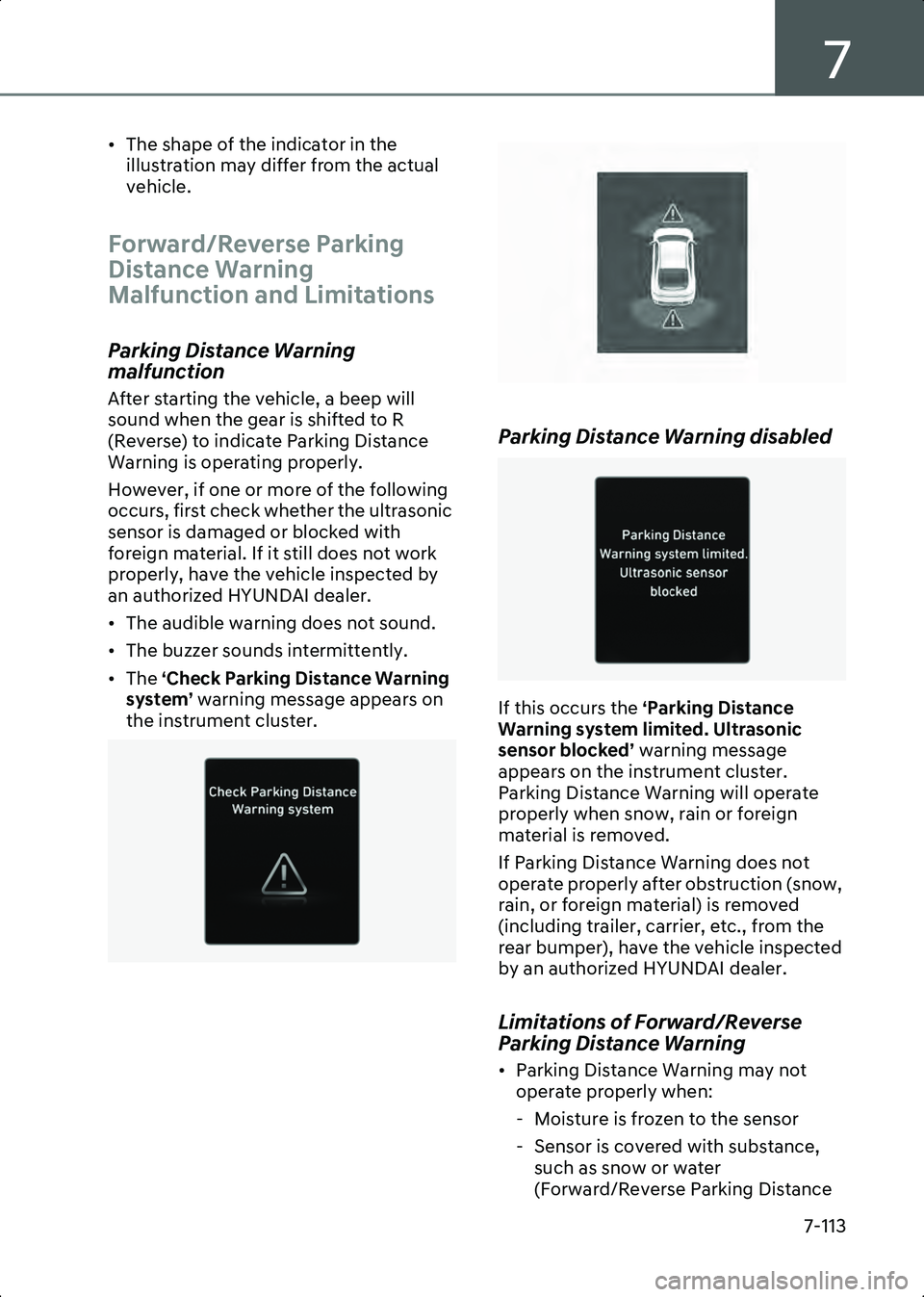
7
7-113
• The shape of the indicator in the illustration may differ from the actual
vehicle.
Forward/Reverse Parking
Distance Warning
Malfunction and Limitations
Parking Distance Warning
malfunction
After starting the vehicle, a beep will
sound when the gear is shifted to R
(Reverse) to indicate Parking Distance
Warning is operating properly.
However, if one or more of the following
occurs, first check whether the ultrasonic
sensor is damaged or blocked with
foreign material. If it still does not work
properly, have the vehicle inspected by
an authorized HYUNDAI dealer.
• The audible warning does not sound.
• The buzzer sounds intermittently.
• The ‘Check Parking Distance Warning
system’ warning message appears on
the instrument cluster.
B0377EU01 B7007302
Parking Distance Warning disabled
B0377EU03
If this occurs the
‘Parking Distance
Warning system limited. Ultrasonic
sensor blocked’ warning message
appears on the instrument cluster.
Parking Distance Warning will operate
properly when snow, rain or foreign
material is removed.
If Parking Distance Warning does not
operate properly after obstruction (snow,
rain, or foreign material) is removed
(including trailer, carrier, etc., from the
rear bumper), have the vehicle inspected
by an authorized HYUNDAI dealer.
Limitations of Forward/Reverse
Parking Distance Warning
• Parking Distance Warning may not operate properly when:
- Moisture is frozen to the sensor
- Sensor is covered with substance, such as snow or water
(Forward/Reverse Parking Distance
Hyundai_CE_en_US.book Page 113
Page 462 of 582
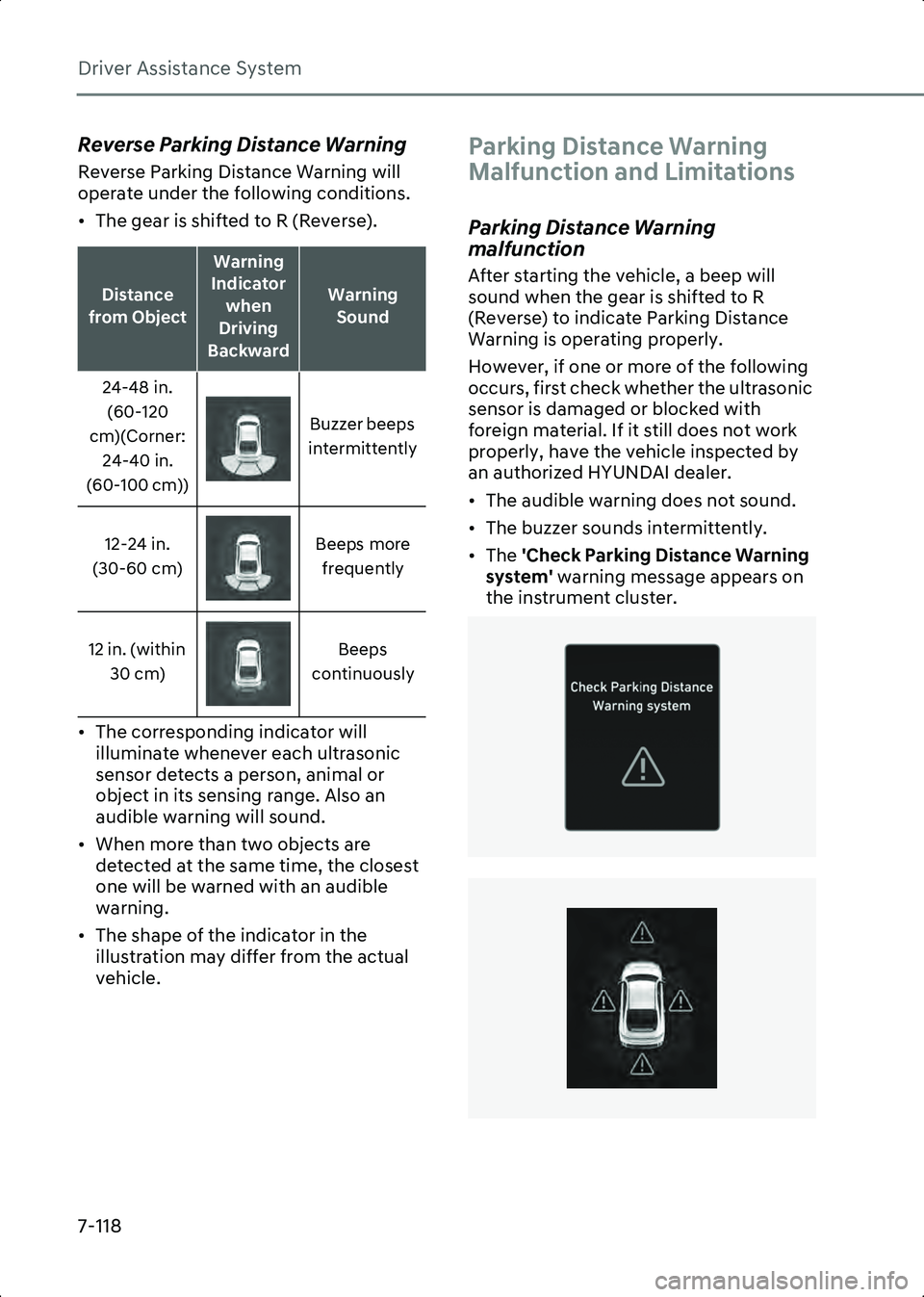
Driver Assistance System
7-118
Reverse Parking Distance Warning
Reverse Parking Distance Warning will
operate under the following conditions.
• The gear is shifted to R (Reverse).
• The corresponding indicator will illuminate whenever each ultrasonic
sensor detects a person, animal or
object in its sensing range. Also an
audible warning will sound.
• When more than two objects are detected at the same time, the closest
one will be warned with an audible
warning.
• The shape of the indicator in the illustration may differ from the actual
vehicle.
Parking Distance Warning
Malfunction and Limitations
Parking Distance Warning
malfunction
After starting the vehicle, a beep will
sound when the gear is shifted to R
(Reverse) to indicate Parking Distance
Warning is operating properly.
However, if one or more of the following
occurs, first check whether the ultrasonic
sensor is damaged or blocked with
foreign material. If it still does not work
properly, have the vehicle inspected by
an authorized HYUNDAI dealer.
• The audible warning does not sound.
• The buzzer sounds intermittently.
• The 'Check Parking Distance Warning
system' warning message appears on
the instrument cluster.
OJWEV071232L
B7007702
Distance
from Object
Warning
Indicator when
Driving
Backward
Warning Sound
24-48 in. (60-120
cm)(Corner: 24-40 in.
(60-100 cm)) Buzzer beeps
intermittently
12-24 in.
(30-60 cm) Beeps more
frequently
12 in. (within 30 cm) Beeps
continuously
Hyundai_CE_en_US.book Page 118
Page 463 of 582
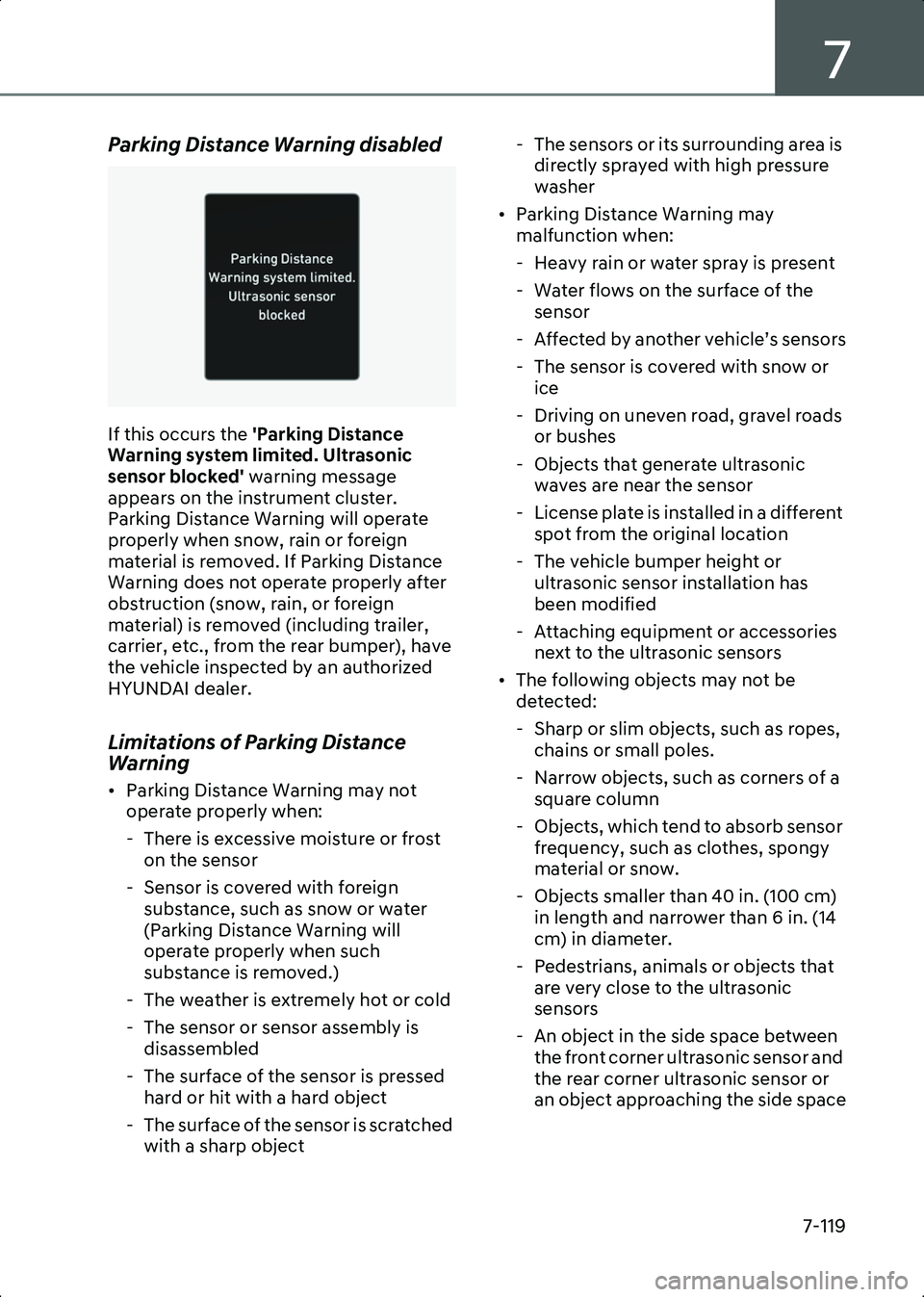
7
7-119
Parking Distance Warning disabled
OJWEV071233L
If this occurs the 'Parking Distance
Warning system limited. Ultrasonic
sensor blocked' warning message
appears on the instrument cluster.
Parking Distance Warning will operate
properly when snow, rain or foreign
material is removed. If Parking Distance
Warning does not operate properly after
obstruction (snow, rain, or foreign
material) is removed (including trailer,
carrier, etc., from the rear bumper), have
the vehicle inspected by an authorized
HYUNDAI dealer.
Limitations of Parking Distance
Warning
• Parking Distance Warning may not operate properly when:
- There is excessive moisture or frost on the sensor
- Sensor is covered with foreign substance, such as snow or water
(Parking Distance Warning will
operate properly when such
substance is removed.)
- The weather is extremely hot or cold
- The sensor or sensor assembly is disassembled
- The surface of the sensor is pressed hard or hit with a hard object
- The surface of the sensor is scratched with a sharp object - The sensors or its surrounding area is
directly sprayed with high pressure
washer
• Parking Distance Warning may malfunction when:
- Heavy rain or water spray is present
- Water flows on the surface of the sensor
- Affected by another vehicle’s sensors
- The sensor is covered with snow or ice
- Driving on uneven road, gravel roads or bushes
- Objects that generate ultrasonic waves are near the sensor
- License plate is installed in a different spot from the original location
- The vehicle bumper height or ultrasonic sensor installation has
been modified
- Attaching equipment or accessories next to the ultrasonic sensors
• The following objects may not be detected:
- Sharp or slim objects, such as ropes, chains or small poles.
- Narrow objects, such as corners of a square column
- Objects, which tend to absorb sensor frequency, such as clothes, spongy
material or snow.
- Objects smaller than 40 in. (100 cm) in length and narrower than 6 in. (14
cm) in diameter.
- Pedestrians, animals or objects that are very close to the ultrasonic
sensors
- An object in the side space between the front corner ultrasonic sensor and
the rear corner ultrasonic sensor or
an object approaching the side space
Hyundai_CE_en_US.book Page 119
Page 466 of 582
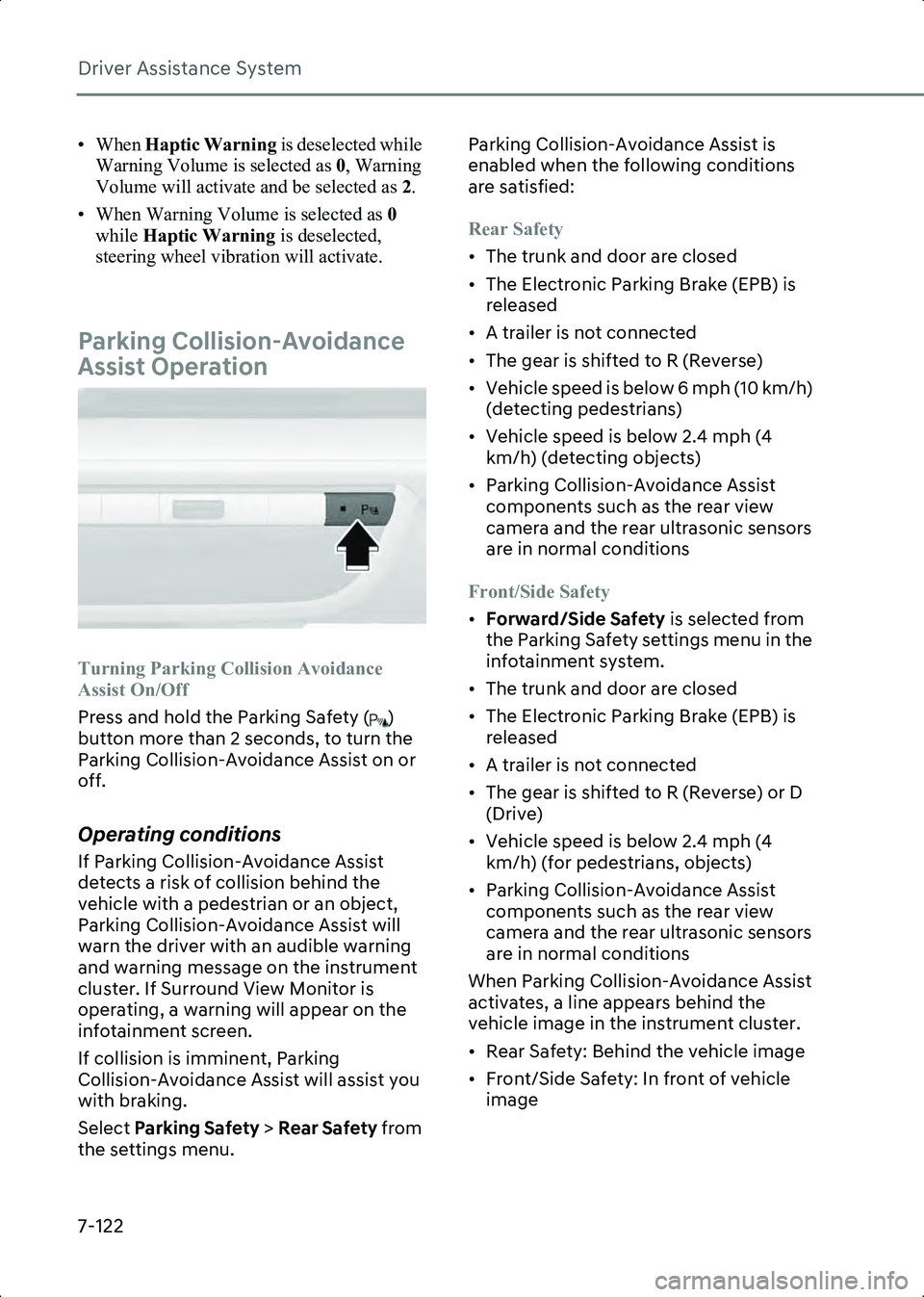
Driver Assistance System
7-122
• When Haptic Warning is deselected while
Warning Volume is selected as 0, Warning
Volume will activate and be selected as 2.
• When Warning Volume is selected as 0
while Haptic Warning is deselected,
steering wheel vibration will activate.
Parking Collision-Avoidance
Assist Operation
B7008001
Turning Parking Collision Avoidance
Assist On/Off
Press and hold the Parking Safety ( )
button more than 2 seconds, to turn the
Parking Collision-Avoidance Assist on or
off.
Operating conditions
If Parking Collision-Avoidance Assist
detects a risk of collision behind the
vehicle with a pedestrian or an object,
Parking Collision-Avoidance Assist will
warn the driver with an audible warning
and warning message on the instrument
cluster. If Surround View Monitor is
operating, a warning will appear on the
infotainment screen.
If collision is imminent, Parking
Collision-Avoidance Assist will assist you
with braking.
Select Parking Safety > Rear Safety from
the settings menu. Parking Collision-Avoidance Assist is
enabled when the following conditions
are satisfied:
Rear Safety
• The trunk and door are closed
• The Electronic Parking Brake (EPB) is
released
• A trailer is not connected
• The gear is shifted to R (Reverse)
• Vehicle speed is below 6 mph (10 km/h) (detecting pedestrians)
• Vehicle speed is below 2.4 mph (4 km/h) (detecting objects)
• Parking Collision-Avoidance Assist components such as the rear view
camera and the rear ultrasonic sensors
are in normal conditions
Front/Side Safety
• Forward/Side Safety is selected from
the Parking Safety settings menu in the
infotainment system.
• The trunk and door are closed
• The Electronic Parking Brake (EPB) is released
• A trailer is not connected
• The gear is shifted to R (Reverse) or D (Drive)
• Vehicle speed is below 2.4 mph (4 km/h) (for pedestrians, objects)
• Parking Collision-Avoidance Assist components such as the rear view
camera and the rear ultrasonic sensors
are in normal conditions
When Parking Collision-Avoidance Assist
activates, a line appears behind the
vehicle image in the instrument cluster.
• Rear Safety: Behind the vehicle image
• Front/Side Safety: In front of vehicle image
Hyundai_CE_en_US.book Page 122
Page 467 of 582
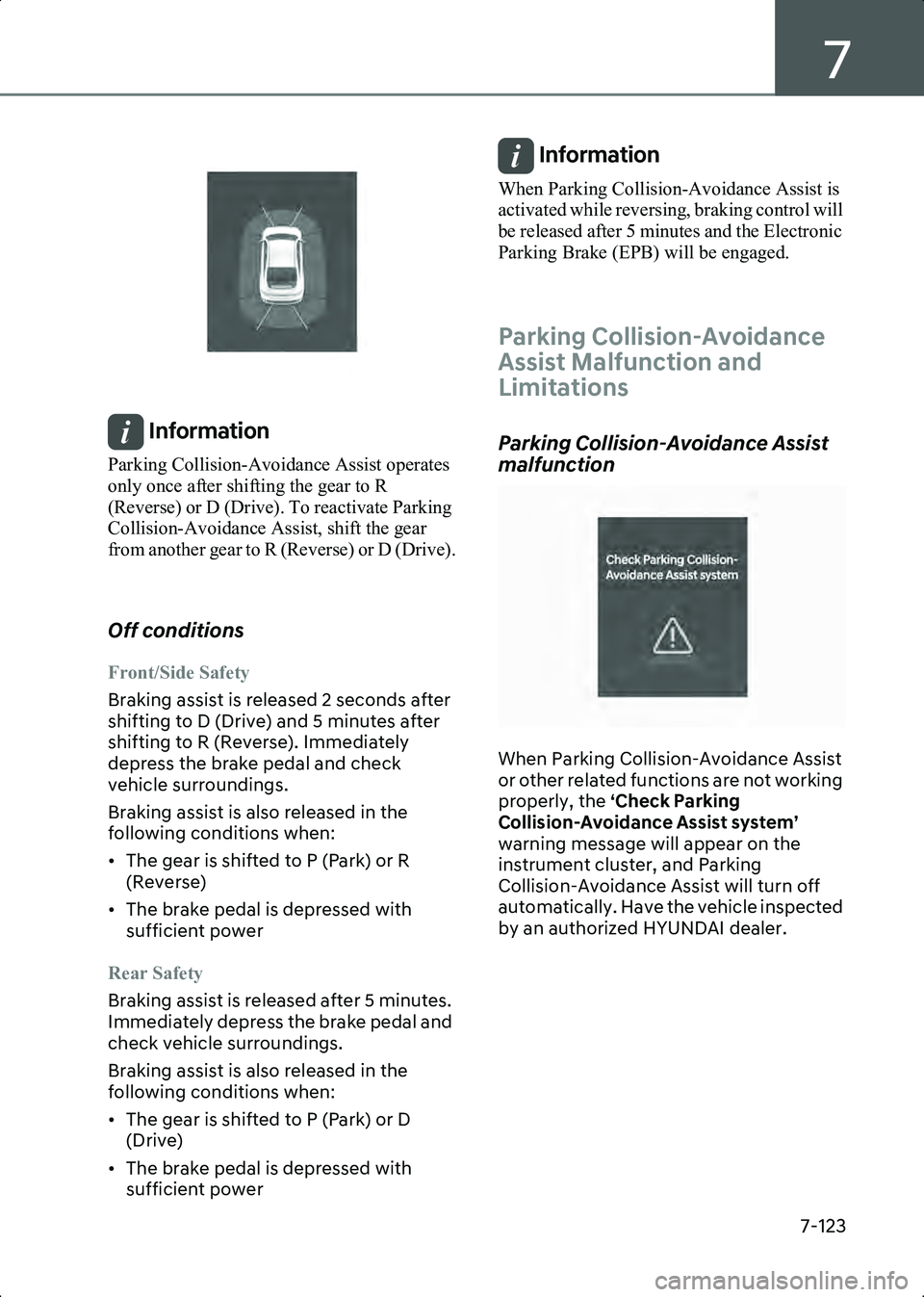
7
7-123
B7008002
Information Parking Collision-Avoidance Assist operates
only once after shifting the gear to R
(Reverse) or D (Drive). To reactivate Parking
Collision-Avoidance Assist, shift the gear
from another gear to R (Reverse) or D (Drive).
Off conditions
Front/Side Safety
Braking assist is released 2 seconds after
shifting to D (Drive) and 5 minutes after
shifting to R (Reverse). Immediately
depress the brake pedal and check
vehicle surroundings.
Braking assist is also released in the
following conditions when:
• The gear is shifted to P (Park) or R (Reverse)
• The brake pedal is depressed with sufficient power
Rear Safety
Braking assist is released after 5 minutes.
Immediately depress the brake pedal and
check vehicle surroundings.
Braking assist is also released in the
following conditions when:
• The gear is shifted to P (Park) or D (Drive)
• The brake pedal is depressed with sufficient power
Information When Parking Collision-Avoidance Assist is
activated while reversing, braking control will
be released after 5 minutes and the Electronic
Parking Brake (EPB) will be engaged.
Parking Collision-Avoidance
Assist Malfunction and
Limitations
Parking Collision-Avoidance Assist
malfunction
B7008101
When Parking Collision-Avoidance Assist
or other related functions are not working
properly, the ‘Check Parking
Collision-Avoidance Assist system’
warning message will appear on the
instrument cluster, and Parking
Collision-Avoidance Assist will turn off
automatically. Have the vehicle inspected
by an authorized HYUNDAI dealer.
Hyundai_CE_en_US.book Page 123
Page 468 of 582
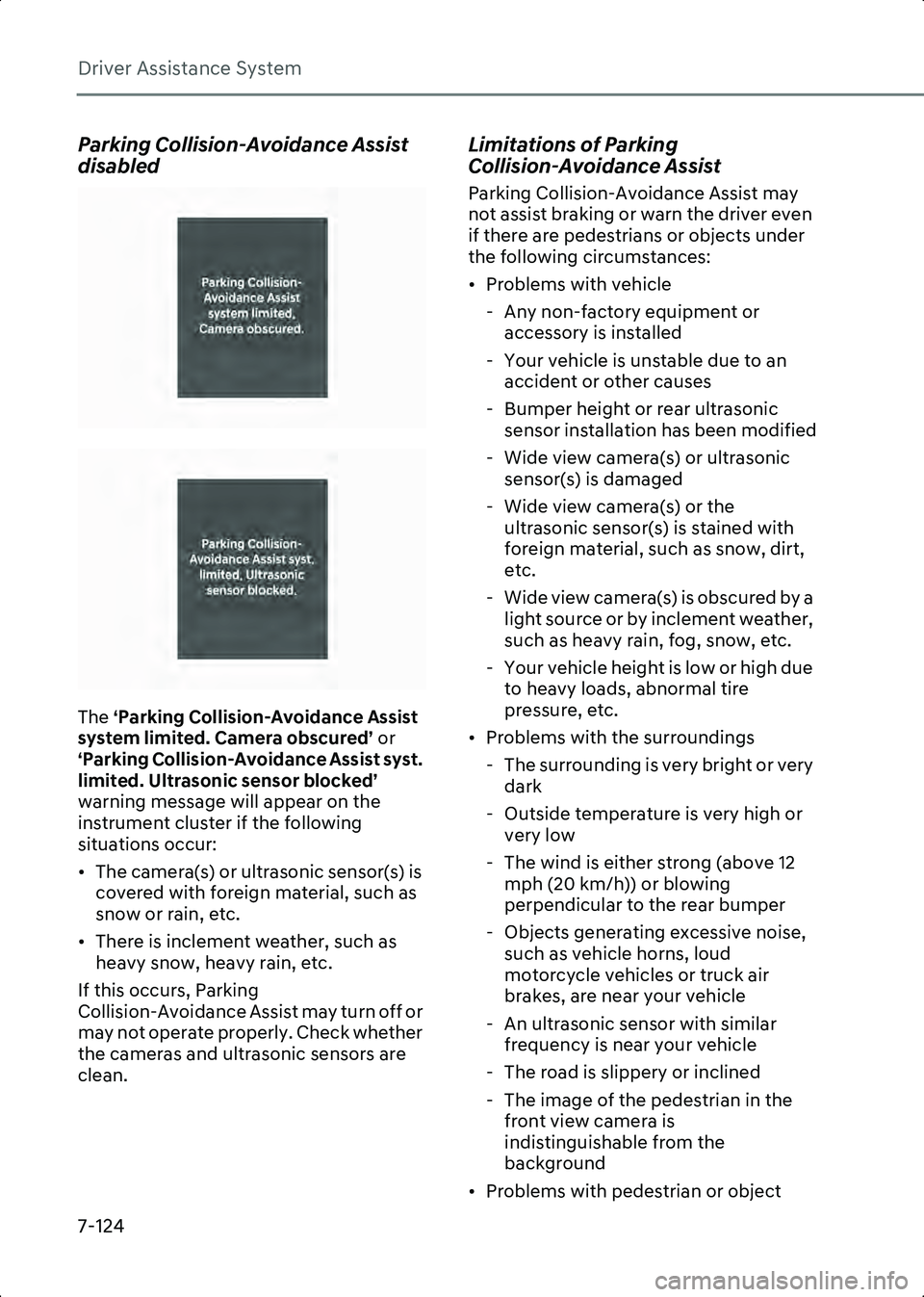
Driver Assistance System
7-124
Parking Collision-Avoidance Assist
disabled
B7008102
B7008103
The ‘Parking Collision-Avoidance Assist
system limited. Camera obscured’ or
‘Parking Collision-Avoidance Assist syst.
limited. Ultrasonic sensor blocked’
warning message will appear on the
instrument cluster if the following
situations occur:
• The camera(s) or ultrasonic sensor(s) is covered with foreign material, such as
snow or rain, etc.
• There is inclement weather, such as heavy snow, heavy rain, etc.
If this occurs, Parking
Collision-Avoidance Assist may turn off or
may not operate properly. Check whether
the cameras and ultrasonic sensors are
clean.
Limitations of Parking
Collision-Avoidance Assist
Parking Collision-Avoidance Assist may
not assist braking or warn the driver even
if there are pedestrians or objects under
the following circumstances:
• Problems with vehicle - Any non-factory equipment or accessory is installed
- Your vehicle is unstable due to an accident or other causes
- Bumper height or rear ultrasonic sensor installation has been modified
- Wide view camera(s) or ultrasonic sensor(s) is damaged
- Wide view camera(s) or the ultrasonic sensor(s) is stained with
foreign material, such as snow, dirt,
etc.
- Wide view camera(s) is obscured by a light source or by inclement weather,
such as heavy rain, fog, snow, etc.
- Your vehicle height is low or high due to heavy loads, abnormal tire
pressure, etc.
• Problems with the surroundings - The surrounding is very bright or very dark
- Outside temperature is very high or very low
- The wind is either strong (above 12 mph (20 km/h)) or blowing
perpendicular to the rear bumper
- Objects generating excessive noise, such as vehicle horns, loud
motorcycle vehicles or truck air
brakes, are near your vehicle
- An ultrasonic sensor with similar frequency is near your vehicle
- The road is slippery or inclined
- The image of the pedestrian in the front view camera is
indistinguishable from the
background
• Problems with pedestrian or object
Hyundai_CE_en_US.book Page 124